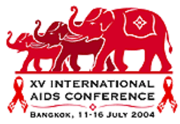 |
 |
 |
| |
IMPACT OF HCV VIREMIA ON HIV DISEASE PROGRESSION IN WOMEN: HCV INCREASES RISK FOR AIDS (WIHS)
|
| |
| |
|
|
| |
| |
 |
|
| |
| |
Reported by Jules LevinPoster B3343 ay XV IAC, July 2004, Bangkok.
Study authors conclude: HCV increases risk of AIDS and AIDS related death, and Cd4 count <200 is strong predictor as well.
A Kovacs, W Du, M DeGiacomo, T Shahidyazdani, D Wright, M J Nowicki
LAC+USC Medical Center Kerk School of Medicine, Los Angeles, CA, United States
Infection with hepatitis C is common among HIV+ women. Studies to date have been conflicting as to the impact of HCV infection on HIV disease progression in women. Spontaneous viral crearance occurs in 20% or more of HCV-infected women, but less frequently in those infected with HIV.
This study included 1367 AIDS-free women enrolled in theWomen's Interagency HIV-1 Study (WIHS) from 6 sites throughout the USA. 520 were HCV-antibody positive, 800 were HCV-antibody negative, and 47 were HCV-antibody status unknown.
HCV viremia was determined for all anti-HCV+ women at baseline and 6-month follow-up using PCR [COBAS AMPLICOR, Roche quantitative PCR (limit of detection >600 IU/mL) followed by qualitative PCR (>50 IU/mL) for negatives]. Clinical and laboratory evaluations, including HIV-1 RNA levels and CD4 counts, were performed at study entry and at 6-month intervals. Univariate analyses, Kaplan-Meier analysis and Cox proportional hazard models were used to determine the risk of developing (AIDS) in the 352 HIV+/HCV + and the 1015 HIV+ women.
RESULTS
HCV+ POSITIVE WOMEN'S DEMOGRAPHICS
16% were white, 62% Black, 19% Hispanic.
74% were 35-54 yrs age, 24% 25-34 yrs.
85% were unemployed.
Number of sexual partners: 9% >100, 23% 11-100, 25% 5-10, 43% 1-4.
Risk factors: IVDU- 75%, heterosexual contact- 20%. For HCV-negative women risk factors: 56% heterosexual contact; IVDU 4%.
Of the anti-HCV+ women, almost 80% (281) were HCV viremic and 20% (71) had apparent viral clearance.
MEDIAN HIV RNA: 14,000 c/ml. 58% had HIV RNA levels > 1000I (28%>55,000; 13%- 20,000-55,000; 22%- 4,000-20,000) & 33% <4000).
Initial HCV RNA 1.5 million IU/ml. 46% <5 million.
After approx. 5 years of follow-up, 464 developed an AIDS defining clinical condition including 379 self-reported AIDS and 85 AIDS-related deaths.
In unadjusted analyses, AIDS was associated with age, employment, treatment, injection drug use, transfusion, baseline CD4 count, baseline HIV RNA level, HCV genotype and baseline HCV RNA. 15 women in this study had HCV RNA >20 million and women in the study with HCV RNA >20 million had 2 times greater increased risk of developing AIDS. Women with HIV RNA >55,000 c/ml had 2 times greater risk for developing AIDS compared to VL <4,000 c/ml. CD4 count ever or at last visit <200 increased risk for AIDS 4 times compared to never having <200 CD4s.
HCV viremia was an independent predictor of AIDS after adjusting for baseline HIV RNA, baseline CD4 and length of HAART. (HCV viremia vs HCV-. Hazard ratio: 1.31; 95% CI: 1.06-1.63; p=0.01).
Although HIV RNA and length of HAART were also independent predictors of AIDS, CD4 count < 200 cells/mm3 was the strongest predictor of outcome (HR: 2.70; 95% CI: 2.18-3.34; p<0.0001).
According to Kaplan-Meier cumulative probability of remaining AIDS free was reduced in HCV+ positive women.
AUTHOR SUMMARY
Among the 347 HCV-antibody positive women tested for HCV RNA, almost 80% had HCV viremia and 20% had apparent clearance.
58% of HCV viremic women had RNA levels >1 million IU/mL and 10% were >5 million IU/mL (median 1.5 million IU/mL). Range 0-38 million). Biologic variability between study visits was <1log HCV RNA in 95% of patients.
By the end of visit 18 (Sep 30, 2003), 564 women developed AIDS defining clinical condition including 507 self-reported AIDS and 57 identified at death.
Kaplan-Meier plots revealed that HCV viremic women were more likely to develop AIDS than HCV antibody negative women.
Cox proportional Hazard model confirmed that HCV viremia was an independent predictor of AIDS after adjusting for time-dependent HIV RNA, CD4, length of HAART and IVDU in the preceeding 6 months.
Although HCV viremia, HIV RNA, IVDU in the preceding 6 months and length of HAART were also independent risk factors of AIDS, cd4 count <200 was the strongest predictor of outcome.
HIV+ women infected with HCV have extremely high HCV RNA levels. Active HCV infection is associated with increase of AIDS or AIDS related deaths in women.
|
| |
|
 |
 |
|
|